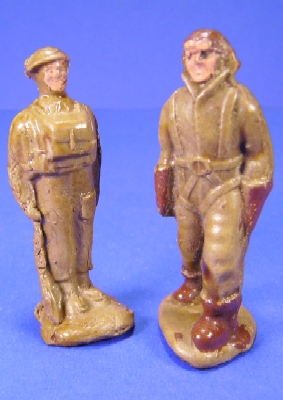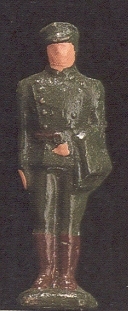Collecting Timpo Toys: 4 fields can be distinguished:
1938
till
1946:
under the name of „Toy Importer“ to the production of
the first metal figure. During world war II metal was
badly needed for military purposes. The toy production
therefore was restricted to articles made of wood
and bakelite, the figures were made of a composition
material named Timpolene (sawdust, glue, porcelain
clay plus X).


Two figures made of Timpolene from the year 1946 height 60 mm
and a chauffeur of Timpolene from 1947 height 40 mm
1946
till
1954
figures made of metal. Today collectors are confused
about three things: 1. Lead and pewter were used as
an alloy. For this reason the figures are often classified
as lead-figures or tin-figures also. 2. The first moulds
were bought from companies like Stoddart and
Kew.They were developed before the war. It is hard to
tell the difference between older castings and TIMPO
originals. Since 1950 TIMPO used their own moulds.
3. Soldiers made by Benbros can be found in TIMPO
boxes. Since 1952 the name of the company changed
to "Model Toys", the trade mark TIMPO however
existed further on. After the production of solid metal
figures TIMPO turned to a technique called „hollow-cast“
developed by William Britains. The models can be
recognized by their low weight and a small air-hole .
Norman Joplin listed and photograhed them all in his
very instructive book. Those figures were partly
flocked with textile fibres to gain a kind of fur look.
The hollow-cast-figure "Wild Bill Hickock", produced
by Benbros, sold in a TIMPO box.
1954/56
till
1958/63
and 1956. There was a campaign in those days to exile
lead from childrens' rooms. The contemporary material
was „plastics“. This is the era of solid plastic figures. The
figures were first commended in a catalogue in 1955 to
be unbreakable and hand-painted.
In the early days hollow-cast-moulds were used to
produce the plastic solids. Norman Tooth remodelled
the moulds for this purpose. I found out that some figures
are different regarding the base. Maybe it is due to
different states of working over of the moulds. The more
recent figures are marked.under the base. Metal figures
are casted upside down, therefore the first plastic castings
are not marked in this place.
The first figures designed only for plastic castings werelisted in the prospect of 1955. Some series vanished over
the years, some were sold for an astonishing long time.
The moulds are made of metal and seem still to be in use.
You can read about this subject in Alfred Plath's beautiful
book.
A cossack, casted 1959 in a mould made
for plastic castings.
beginning of
the sixties
till 1980
generation of this successfull series was partly painted,
TIMPO tried to make the expensive paint obsolete.
The figures were cast in seperate parts consisting of one-
coloured plastic. The single parts were assembled.
The third and fourth generation of these toys were
produced with less seperate parts. A special overmoulding-
procedure made possible to combine plastic parts
made of different colours. In the first and second
generation it was in use already, but had it's blossom
in the fourth generation. In this way TIMPO achieved to
offer highly charming figures in the fashionable colours of
the seventies today estimated as vintage items.
A roman standart bearer made with overmoulding.
The upper body was formed by melting four
different coloured plastic granulates together.
The year of the failure of Model Toys, who sold the
figures over the world, wasn't the end for TIMPO
fortunately. The legendary trade mark TIMPO survived
until today. The TOYWAY company offers TIMPO-products
partly made using the old moulds today.
Some other moulds are also in use today in the hands of
collectors, particular to satisfy the collectors with the
small swoppet parts which always disappear.
I hope this will last for a long, long time!
Contemporary Toyway-figures